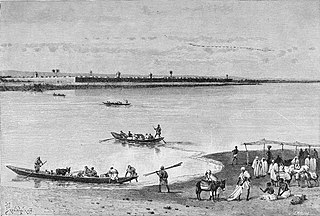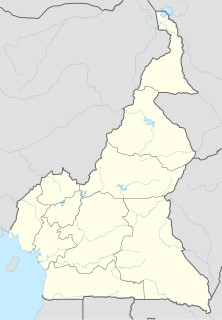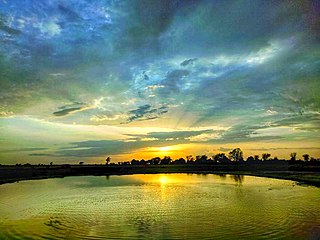Goulfey | |
|---|---|
Commune and town | |
| Country | |
| Time zone | UTC+1 (WAT) |
Goulfey is a town and commune in the Logone-et-Chari department of Cameroon, close to the border of Chad.
Goulfey | |
|---|---|
Commune and town | |
| Country | |
| Time zone | UTC+1 (WAT) |
Goulfey is a town and commune in the Logone-et-Chari department of Cameroon, close to the border of Chad.
Goulfey is located about 50 kilometres north of Kousséri and is separated by the Logone River.
Goulfey is infamous for its practice and techniques of warfare. It was believed to have been founded by Rabat after Djagara led a victory over him with the help of the French.
The history of Goulfey has its from the 16th to 18th centuries during its Arab invasions.
The Arabs found people embedded in ancestral traditions, locally known as the cult of the Varan, which is considered the symbol of Goulfey and a spiritual element of protection and divination. It plays an important political and religious role in the community.
It was often believed that the spirits were known as the Gbwéi-gbwéi, who collaborated with the people through the traditional priest to offer household food, such as honey and milk to the Varans, housed in the tower.
The famous military emperor was Rabah, who came from Egypt to Goulfey in an aim to convert locals to Islam and taking slaves. Its weapons used in battles are still present here.
Goulfey is a centuries-old dwelling. It is a museum and acts as a cultural centre where young people visit to learn about the rich culture of Kotoko.

The Logon or Logone River is a major tributary of the Chari River. The Logone's sources are located in the western Central African Republic, northern Cameroon, and southern Chad. It has two major tributaries: the Pendé River in the prefecture Ouham-Pendé in the Central African Republic and the Mbéré River at the east of Cameroon. Many swamps and wetlands surround the river.

Kousséri, founded and known as Mser in the indigenous Mser language is a city in Far North Province, Cameroon. It is the capital of the Logone-et-Chari department. It is a market town, and its population has recently been swollen by refugees from Chad. It had a population of 89,123 at the 2005 Census. The majority of the population are Shuwa Arabs with Chadian Arabic used as the lingua franca.

Wum is a town and commune in Cameroon. It is the capital of Menchum division in the Northwest Province.

The Far North Region, also known as the Extreme North Region, is the northernmost constituent province of the Republic of Cameroon. It borders the North Region to the south, Chad to the east, and Nigeria to the west. The capital is Maroua.
Afade (Afaɗə) is an Afro-Asiatic language spoken in eastern Nigeria and northwestern Cameroon.
Maslam is an Afro-Asiatic language spoken in northern Cameroon, with a few in southwestern Chad. Dialects are Maslam and Sao. Maslam is in rapid decline.
Balikumbat is a town and commune in Cameroon.
Darak is a town and commune in the Logone-et-Chari department of the Far North Region of Cameroon.
Deuk is a town and commune in Mbam-et-Inoubou department of Centre Region in Cameroon.
Doumé is a town and commune in Cameroon.
Fotokol is a town and commune in Logone-et-Chari Department, Far North Region, Cameroon. It is home to Fotokol High School.
Kai-Kai is a town and commune in Cameroon.

Kalfou, Cameroon is a town and commune in Cameroon.

Logone-Birni is a town and commune in Cameroon. The town lies on the left (west) bank of the Logone River which at this point forms the state boundary between Camaroon and Chad. It is the capital of the Kotoko people, whose two other principal cities are Kousséri and Goulfey.
Mbankomo is a town and commune in Cameroon. Sportive and academic center of Mbankomo is located in Mbankomo

Monatélé is a town and commune in Cameroon and capital of the Lekié Department of the Centre Region. It is composed of many villages.
Nsem is a town and commune in Cameroon.
Ndelele is a town and commune in Cameroon.
Nguelemendouka is a town and commune in Cameroon.
Jina (Zina) is an Afroasiatic language of Cameroon. The Muxule variety may be a distinct language.
Coordinates: 12°23′N14°56′E / 12.383°N 14.933°E